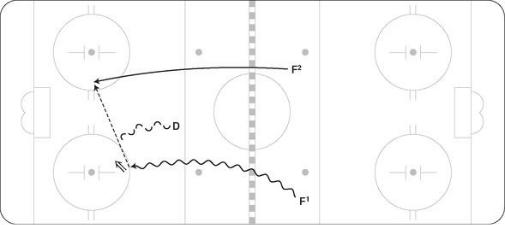
- •Foreword
- •Preface
- •Key to Diagrams
- •Reading Pressure and Options
- •Reacting to Support the Breakout
- •Breakout Plays
- •Control Breakouts
- •Counters
- •Regroups
- •Dump-In Entries
- •Mid-Ice Entries
- •Wide-Lane Drives
- •The Funnel
- •Two-on-One Attacks
- •Two-on-Two Attacks
- •Three-on-Two Attacks
- •Offsides
- •Activating Defense Into Offensive Zone Entries
- •Cycling
- •Playing Behind the Net
- •Stretching the Zone: Low-High Plays
- •Activating Defense in the Offensive Zone
- •Attack Zone Plays
- •Power-Play Breakouts
- •Gaining and Maintaining Possession off the Entry
- •Zone Setup
- •Five-on-Three Power Play
- •Four-on-Three Power Play
- •Forechecking Systems
- •Neutral Zone Forechecking
- •Neutral Zone Forechecking Systems
- •Neutral Zone Backchecking
- •Neutral Zone Backchecking Systems
- •Handling Defensive Zone Entries
- •Defensive Zone Systems
- •Situational Guidelines for Defensive Zone Coverag
- •Face-Offs and Penalty Kills
- •Forechecking and Penalty Kills
- •Pressuring the Entry
- •Defensive Zone Play
- •Three-on-Five Penalty Kill
- •Three-on-Four Penalty Kill
- •Offensive Zone Face-Offs
- •Neutral Zone Face-Offs
- •Defensive Zone Face-Offs
- •Power-Play Face-Offs
- •Penalty-Kill Face-Offs
- •Special Face-Off Situations
- •Managing Staff
- •Dealing With Officials
- •Adjusting Your Playing Strategy
- •Managing Lines
- •Line Changes
- •Handling the Moment
- •Index
- •About the Authors
The Funnel
Sometimes coaches need to have in their back pockets a tactic or philosophy that simplifies the offense into a couple of simple ideas. The funnel (figure 3.10) is one of these. Many coaches like the funnel because its main emphasis is to get pucks to the net through traffic. The funnel philosophy says that once a player carrying the puck crosses the top of the offensive face-off circles, that player has only one option: placing the puck toward the front of the net. Under these instructions, the other two offensive forwards should not be trying to get open for a pass but should be driving hard to the net looking for a second-chance rebound. In other words, everything—the puck and the players—gets funneled toward the front of the net. If 70 to 80 percent of all goals scored come off of a second chance created by a rebound, then the funnel simplifies how to make this happen. In every league the leading scorers are the ones who take the most shots. They understand the funnel philosophy—get the puck to the net. Volume of shots is key.
Figure 3.10 The funnel.

The funnel opportunity gets maximized if the player carrying the puck into the offensive zone and placing the puck toward the front of the net is an offensive defenseman (figure 3.11). Obviously, this frees up all three offensive forwards to skate into prime position and jump on any loose pucks to create second shots. When shooting from the outside players should recognize that they aren’t trying to score. At most levels the goaltending is too good and few are beat from these wide angles. The main objective is to hit the net and create a rebound for the players going to the net. Therefore shoot low for the wide pad and 90% of the time a rebound will come out into the slot. It is very difficult for any goaltender to deflect this type of shot to the outside.
Figure 3.11 The funnel with an offensive defenseman.

The funnel play is also a simple way to activate the mid-ice defenseman. If the defenseman on the rush has speed to attack the net off the rush, then many coaches give the attacking defenseman permission to attack the front of the net, with one rule—once the play turns from a rush to a forecheck, the attacking defenseman must return quickly and directly to the blue line. Another simple rule for the offensive defenseman joining the rush or joining the attack is the function of time. Many coaches prefer that their defensemen not join the rush or the attack with minutes to go in the period or the game, especially if the team is winning by a certain margin.

Two-on-One Attacks
When the offensive team realizes they have a potential two-on-one opportunity in the neutral zone, they should attack quickly with speed (figure 3.12). Initially they may cross, but it is important to attack with speed so that the backcheckers don’t catch them and nullify the odd-man rush. If it is a wide two on one, players should try to get closer to mid-ice right away. Regardless of what side the puck carrier is on once he crosses the blue line he should get the puck into a triple-threat position. A triple threat position is when the puck carrier keeps the puck at his side in shooting position so that he can either pass, shoot, or make a move. The puck carrier now needs to read how the defense and goaltender might play the situation and pick the best option. The second offensive player must have his stick in a position to shoot or deflect the puck into the net.
Figure 3.12 A two-on-one attack.
